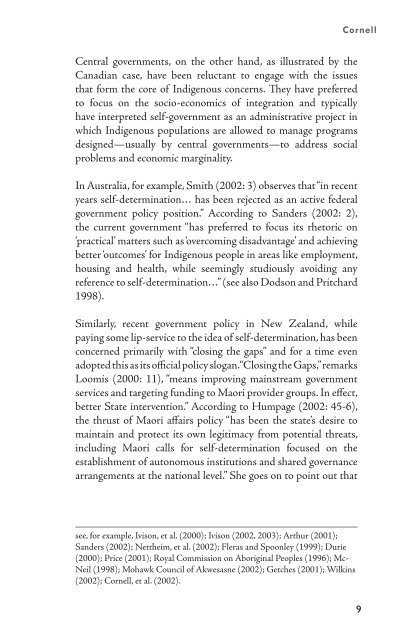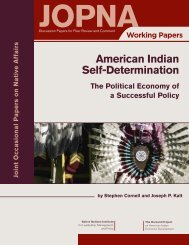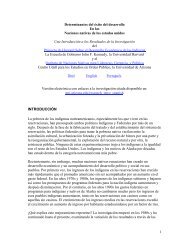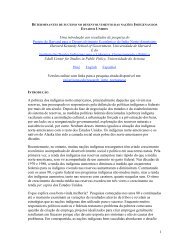<strong>Indigenous</strong> <strong>Peoples</strong>, <strong>Poverty</strong> <strong>and</strong> <strong>Self</strong>-<strong>Determ<strong>in</strong>ation</strong>those ties, of shared cultural practice <strong>and</strong> of collective memory.Both perspectives support the right of <strong>Indigenous</strong> peoples todeterm<strong>in</strong>e their own futures <strong>and</strong> control their own affairs.More specifically, this means the right to shape the political orderof which they are a part, from their relationship with encompass<strong>in</strong>gsocieties to the <strong>in</strong>stitutions by which they govern themselves—<strong>in</strong>clud<strong>in</strong>g the laws to which they <strong>and</strong> others are subject <strong>in</strong> theirown l<strong>and</strong>s—<strong>and</strong> thereby to maximize their control over l<strong>and</strong>s<strong>and</strong> resources, cultural <strong>and</strong> civil affairs, <strong>and</strong> the nature <strong>and</strong> qualityof community life. These peoples have seldom sought, <strong>in</strong> recentdecades, complete separation from those encompass<strong>in</strong>g societies.Instead, they generally have envisioned “nations with<strong>in</strong>” status(Fleras <strong>and</strong> Elliott 1992), or what Anaya (1996: 112) describesas “on the one h<strong>and</strong> autonomy <strong>and</strong> on the other participatoryengagement” <strong>in</strong> the encompass<strong>in</strong>g whole, an arrangement <strong>in</strong> which<strong>Indigenous</strong> peoples “are appropriately viewed as simultaneouslydist<strong>in</strong>ct from yet parts of larger units of social <strong>and</strong> political<strong>in</strong>teraction” (see also Behrendt 2001; S<strong>and</strong>ers 2002).The outcomes of their efforts have varied across these cases.<strong>Indigenous</strong> groups have won some battles <strong>in</strong> pursuit of these ends,lead<strong>in</strong>g to policy changes of various k<strong>in</strong>ds, to exp<strong>and</strong>ed <strong>Indigenous</strong>self-rule with<strong>in</strong> limited policy doma<strong>in</strong>s, to an <strong>in</strong>creased <strong>Indigenous</strong>voice <strong>in</strong> certa<strong>in</strong> political affairs, <strong>and</strong> to the return of some l<strong>and</strong>s<strong>and</strong> other resources. Other battles, however, have been lost, <strong>and</strong>the most fundamental issues of status <strong>and</strong> rights rema<strong>in</strong>, <strong>in</strong> allfour cases, substantially unresolved. . Anaya (1996: 81) describes self-determ<strong>in</strong>ation as consist<strong>in</strong>g of “two normativestra<strong>in</strong>s: First, <strong>in</strong> what may be called its constitutive aspect, self-determ<strong>in</strong>ationrequires that the govern<strong>in</strong>g <strong>in</strong>stitutional order be substantially the creationof processes guided by the will of the people, or peoples, governed. Second,<strong>in</strong> what may be called its ongo<strong>in</strong>g aspect, self-determ<strong>in</strong>ation requires that thegovern<strong>in</strong>g <strong>in</strong>stitutional order, <strong>in</strong>dependently of the processes lead<strong>in</strong>g to itscreation or alteration, be one under which people may live <strong>and</strong> develop freelyon a cont<strong>in</strong>uous basis.”. The literature on <strong>in</strong>digenous status <strong>and</strong> rights <strong>in</strong> these societies is vast, but
CornellCentral governments, on the other h<strong>and</strong>, as illustrated by theCanadian case, have been reluctant to engage with the issuesthat form the core of <strong>Indigenous</strong> concerns. They have preferredto focus on the socio-economics of <strong>in</strong>tegration <strong>and</strong> typicallyhave <strong>in</strong>terpreted self-government as an adm<strong>in</strong>istrative project <strong>in</strong>which <strong>Indigenous</strong> populations are allowed to manage programsdesigned—usually by central governments—to address socialproblems <strong>and</strong> economic marg<strong>in</strong>ality.In <strong>Australia</strong>, for example, Smith (2002: 3) observes that “<strong>in</strong> recentyears self-determ<strong>in</strong>ation… has been rejected as an active federalgovernment policy position.” Accord<strong>in</strong>g to S<strong>and</strong>ers (2002: 2),the current government “has preferred to focus its rhetoric on‘practical’ matters such as ‘overcom<strong>in</strong>g disadvantage’ <strong>and</strong> achiev<strong>in</strong>gbetter ‘outcomes’ for <strong>Indigenous</strong> people <strong>in</strong> areas like employment,hous<strong>in</strong>g <strong>and</strong> health, while seem<strong>in</strong>gly studiously avoid<strong>in</strong>g anyreference to self-determ<strong>in</strong>ation…” (see also Dodson <strong>and</strong> Pritchard1998).Similarly, recent government policy <strong>in</strong> New Zeal<strong>and</strong>, whilepay<strong>in</strong>g some lip-service to the idea of self-determ<strong>in</strong>ation, has beenconcerned primarily with “clos<strong>in</strong>g the gaps” <strong>and</strong> for a time evenadopted this as its official policy slogan. “Clos<strong>in</strong>g the Gaps,” remarksLoomis (2000: 11), “means improv<strong>in</strong>g ma<strong>in</strong>stream governmentservices <strong>and</strong> target<strong>in</strong>g fund<strong>in</strong>g to Maori provider groups. In effect,better State <strong>in</strong>tervention.” Accord<strong>in</strong>g to Humpage (2002: 45-6),the thrust of Maori affairs policy “has been the state’s desire toma<strong>in</strong>ta<strong>in</strong> <strong>and</strong> protect its own legitimacy from potential threats,<strong>in</strong>clud<strong>in</strong>g Maori calls for self-determ<strong>in</strong>ation focused on theestablishment of autonomous <strong>in</strong>stitutions <strong>and</strong> shared governancearrangements at the national level.” She goes on to po<strong>in</strong>t out thatsee, for example, Ivison, et al. (2000); Ivison (2002, 2003); Arthur (2001);S<strong>and</strong>ers (2002); Nettheim, et al. (2002); Fleras <strong>and</strong> Spoonley (1999); Durie(2000); Price (2001); Royal Commission on Aborig<strong>in</strong>al <strong>Peoples</strong> (1996); Mc-Neil (1998); Mohawk Council of Akwesasne (2002); Getches (2001); Wilk<strong>in</strong>s(2002); Cornell, et al. (2002).
- Page 1 and 2: Joint Occasional Papers on on Nativ
- Page 3 and 4: CornellIndigenous Peoples, Poverty
- Page 5 and 6: CornellIndigenous Peoples, Poverty
- Page 7 and 8: CornellIndigenous Peoples, Poverty
- Page 9 and 10: CornellObviously the differences ar
- Page 11 and 12: CornellCommonalitiesAlthough there
- Page 13: CornellThe present inquiry, while p
- Page 17 and 18: Cornellstark discrepancy between In
- Page 19 and 20: Cornellusual economic factors such
- Page 21 and 22: CornellThe meaning and role of self
- Page 23 and 24: Cornellis needed. Those nations mak
- Page 25 and 26: CornellThe U.S. government had inad
- Page 27 and 28: CornellSuch variation does not nega
- Page 29 and 30: CornellBern and Dodds discuss the s
- Page 31 and 32: Cornellgroup identities and boundar
- Page 33 and 34: CornellThe overall policy implicati
- Page 35 and 36: CornellReferencesAnaya, S.J. 1996.
- Page 37 and 38: Cornell-----. 1995. ‘Where does e
- Page 39 and 40: CornellHarvard Project on American
- Page 41 and 42: CornellJorgensen, M., and J. Taylor
- Page 43 and 44: CornellNative Nations Institute for
- Page 45 and 46: CornellWakeling, S., M. Jorgensen,
- Page 47 and 48: Joint Occasional Papers on Native A







